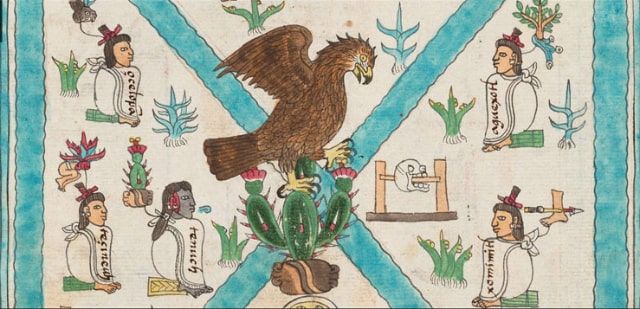The Codex Mendoza: the history and value of ancestral roots
There are 71 pages in the Codex Mendoza: a list of tlatoanis, a register of the subjugated peoples, and a narration of the daily life of the Mexica. The codices were instruments used by ancient Mesoamerican peoples to preserve and transmit their knowledge, traditions, and wisdom.

The history of the Codex Mendoza begins in the middle of the 16th century, after the great Tenochtitlan, the capital city of the Aztecs, had been besieged and defeated, at the beginning of the Spanish domination.
Don Antonio de Mendoza, first viceroy of New Spain, wanted the emperor Charles V to know first hand some facts of his new dominions, for which he gave a number of sheets of European paper to the defeated indigenous nobles so that they could write about themselves: their history, their economy, and their daily life.
The fleet carrying the Codex Mendoza to Europe was seized by the French and the manuscript was acquired by the cosmographer of King Henry II, André Thevet. He sold it to Hakluyt, who in turn gave it to Purchas. Purchas died in 1616 and left the codex in the hands of John Selden When he died in 1654, the codex passed to the Bodley Library in Oxford, where it remains to this day This codex has been edited several times, in black and white and in color.
The Codex Mendoza is a Mexican pictographic manuscript painted by the Nahua indigenous people between 1541 and 1542, by order of Don Antonio de Mendoza, viceroy of New Spain. The pictographs were hastily interpreted in Spanish before being sent to Charles V, King of Spain, so they have glosses in Latin characters. For this reason, we find ourselves before a colonial codex, mixed, with a European book format, whose content is historical and economic.
This manuscript of 71 folios comprises three parts:
The first part, of a historical nature, is a copy of an ancient chronicle - now disappeared - that narrates, year after year, the deeds of arms that the lords of Mexico-Tenochtitlan carried out during 200 years.
The second part, a list of tributes, is a copy of an ancient list paid by 400 towns to Moctezuma, the last lord of Mexico-Tenochtitlan.
The third part has an ethnographic character. The pictographs narrate the life of a Mexican from birth to death.
Codex Mendoza; the most comprehensive account on Mexico-Tenochtitlan
The first section begins with the history of the foundation of Mexico-Tenochtitlan and the legend of the eagle perched on a tunal as a divine sign sent by the god Huitzilopochtli to establish its settlement; among other characters appears Tenoch, a priest who is shown sitting on a mat while appreciating the portent.
In this section the period in which each one of the tlatoanis was in power from the foundation of Mexico-Tenochtitlan and until the fall of Moctezuma Xocoyotzin is marked; likewise, the towns that conquered the Mexica empire are enlisted.
The second section presents the extent of Mexica power, the conquered peoples, and the tributes they paid, such as corn, beans, weapons, eagles, quetzal feathers, gold, among other things.
Finally, the last section includes more specific features such as social organization and customs. It describes the education in schools and the instruction in the Army; it breaks down the types of warriors, their weapons and alludes to their triumphs; various trades, festivals, ceremonies, games, and traditions are presented; there are even laminas that show the interior of the palace of Moctezuma. Likewise, its system of justice is exposed listing great crimes and the way to punish them.
Unlike other codices, Codex Mendoza was not made on deerskin but on Spanish paper and was not mounted as a screen, but was bound so that the king of Spain could understand it. These are some of the oppositions between systems of thought that are concentrated in this codex; however, it is one of the most important documents to understand the history of Mexico before the conquest.
In 2015 the National Institute of Anthropology and History launched, as a form of virtual repatriation, a platform where the codex can be consulted in its entirety digitally.
What are codices, how many types of them exist, who made them, and what they were used for?
The codices have been defined as those pre-Hispanic and colonial pictographic documents where the traditional indigenous writing is expressed. If we observe these documents, we will find an immense variety of them. The codices can be of many types, according to the element that we consider. If we take into account their period of manufacture, they can be pre-Hispanic or colonial. On the other hand, if we think about their support or the material they are made of, we will see that there are cotton canvases, amates, animal skins, some probably of maguey, and others of European paper.
They can also be classified according to their format or presentation and we will have vertical and horizontal strips, screens, canvases, sheets, panels, and books of various sizes. The size of the codices can vary from a strip measuring 7 meters to a small book that fits in your pocket. Here it should be made clear that even if a codex is small, it is no less important than a larger one, but what we should think about is that both respond to the historical needs of a given moment.
If we pay attention to their content, we can find historical, geographical, economic, genealogical, religious, juridical codices. One can imagine that if the codices are "the books" that the indigenous people, pre-Hispanic and colonial, elaborated to register and perpetuate everything that was of interest to the community at a given historical moment, the possible themes can be very numerous.
Another type of codices are those that contain, in addition to pictographs or glyphs, Latin characters in Spanish or Nahuatl. This is frequent for colonial codices, whether they were written simultaneously with both scripts or whether they were first written with pictographs and then interpreted with our alphabet. In such cases, we are dealing with mixed codices.
The codices were made in pre-Hispanic times and continued to be made until the 18th century due to historical, economic, and political needs.
If they are so varied and so different, why do we call them all codices? The word codex comes from the Latin codex and means book; it refers to ancient manuscripts, mainly from the old continent. The Spaniards used this term when they encountered Mesoamerican manuscripts. The term used by the indigenous people is amoxtli -which in Nahuatl means book- and would be the most appropriate to refer to Mexican codices, however, that custom has survived to the present day and that is how we know them and will continue to call them until the indigenous term is imposed.
All these very different manuscripts have in common that they were written by specialists called tlacuilos, who were painters, scribes, and true sages. They captured in the codices various themes through writing, which fixed the indigenous language by means of a system that uses the codified image and derives from artistic conventions.
The writing of the ancient inhabitants of Mesoamerica, like all the writings of the world, had its own characteristics. The peculiarity of this writing lies in the fact that it is, at the same time, painting and text, so to understand it and to be able to read it we have to take into account its plastic parameters, that is to say, everything that intervenes in the work of a painter: perspective, color, planes in space, space itself, the size of each and every one of the drawings, how these are associated with each other, etc. All these plastic aspects will help us and allow reading in the language of origin, in this case, Nahuatl.
This pictorial text also contains grammatical, phonetic, and symbolic aspects.
As you can see, it is very complex writing that, moreover, has not been considered as a total, since the arrival of the Spaniards until today. Few serious researchers have approached the decipherment of this script as a problem to be solved. Better, full of prejudices and lacking a systematic method to face the problem, they prefer to call it, at best, semi-writing.
This type of research tries to find in the indigenous writing the parameters of the European writing, they think that it is not complete writing because they do not find in it an alphabet which, in fact, it does not have; its conventions are others, belonging to the culture that created them. Furthermore, these investigations place alphabetic writing in the highest degree of development of an evolutionary line in which pictographic scripts did not even become writing.
It does not make sense to speak of more or less evolved forms, since each society will have to exhibit those types of writing that are connatural to it. Nor can we think that all scripts must follow the same changes until reaching a supposed evolutionary perfection, but simply that they belong to different genres of writing, with their own changes, according to their historical avatars.
Sources: Cultura, INAH, Hilda J. Aguirre Beltrán




